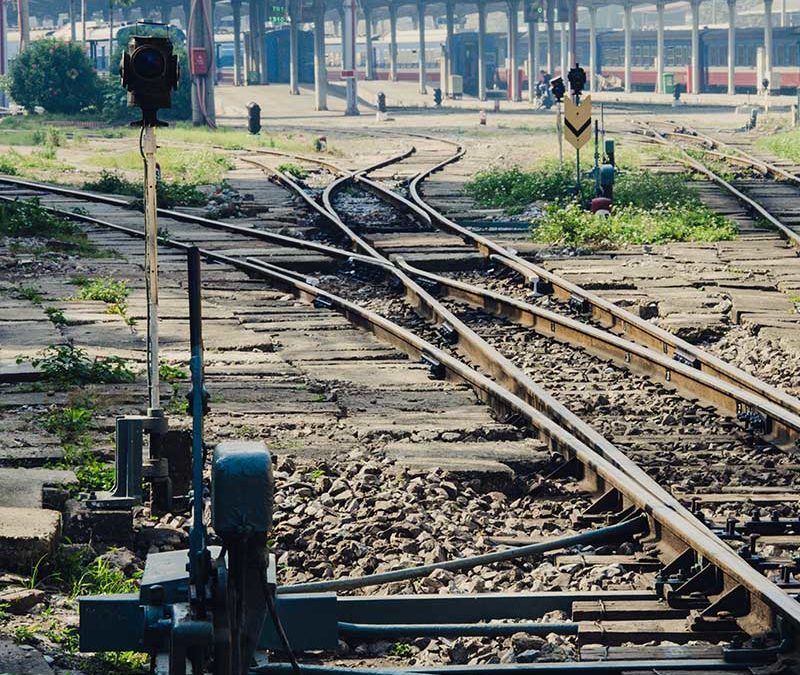Are you new to the railway industry? We have many terms and names that you may find unfamiliar and confusing. Have no fear because we’ve compiled this quick guide to understanding and using railway terminology. For those with little to no experience in the railway and logistics industry, here are a few high-level words to know:
People and roles
There are many people involved in track building, operation, and maintenance:
- Carrier – A transportation company that “carries” your consignment (your shipment).
- Consignor – The person (or company) sending the shipment.
- Consignee – The recipient of a shipment.
- Consignment – The shipment itself.
- Railway Yard Worker – Staff who regulates yard traffic, couples and uncouples trains, and performs other yard-related duties.
- Rail Technicians or Maintenance – Staff responsible for visual inspections of tracks and components (may include replacing worn-out parts, greasing points, cleaning, repacking ballast, and other general upkeep).
Locations and places
To denote specific parts of railroad infrastructure, you’ll often see railways terminology used to describe locations on the line:
- Railway and Railroad Infrastructure – Covers all fixed assets to support a rail line.
- Rolling Stock – Trains that travel along the railroad infrastructure, including passenger coaches, locomotives, and freight cars.
- Track – Rails, ties, and fastening over which cars and trains are moved.
- Main Line – Rail lines without switch tracks, branches, yards, and terminals (like a “highway” for trains).
- Main Track – A rail track that extends through yards between stations.
- Yard – A system of tracks within a specific area where container trains wait to be connected to a train
- Spur – A track leading away from a mainline to a specific facility.
- Crossing – Where two train lines intersect at grade.
- Passing Track (or Siding) – an auxiliary track used for meeting or passing trains.
Railway Terminology: parts and components
This is our area of expertise at North American Rail Products (NARP), so this list of railway terminology is a bit longer than the rest:
- Ballast – Rock or gravel placed on the roadbed to hold the track in line and surface.
- Blank Rails – Rails with no bolt holes.
- Bond – A cable or piece of metal that connects two rails to create an electrical circuit.
- Branding – These identifiers on the rail indicate the weight of the rail, section number, manufacturer and mill name, and year/month rolled.
- Clips: Small metal plates that secure rails to beams with bolts.
- Continuous Welded Rail – Over 400 feet of rails welded together.
- Fastenings – These include joint bars, bolts, and spikes:
- Joint Bar – used to unite abutting ends of rails.
- Spikes – a large nail used to secure rails and base plates to railroad ties.
- Frog – A track structure found where two rails intersect. It provides structure and support for wheels on either rail to cross to the other.
- Gauge – Three terms use this word:
- Gauge line – a line found 5/8″ below the top of a head on the running side of a rail.
- Track Gauge – Distance between gauge lines at right angles (standard gauge is 4’8.5”).
- Track Tool Gauge – Tool used to measure gauges.
- O.T.M. (Other Track Material) – Term used to describe miscellaneous rail materials (not including rails and ties).
- Plug, Tie – Rectangular pieces of wood shaped like spikes used for driving holes when spikes have been withdrawn.
- Tie Plate – A plate installed between 2 lines.
- Running Rail – The rail that carries the weight (compared to a guard or flange rail that carries no weight).
- Switch – A track structure used to divert a train from one track to another. A Switch Stand allows for the manual operation of switches.
For more railroad parts definitions (including commonly used railroad tools), read our recent article on choosing the best track tools and materials for smooth and efficient operations.
Making trains go (or stop)
When designing rail tracks, devices and parts can be installed on the rails to help trains go or stop:
- Car Retarder (or Retarder) – Braking device on rails meant to slow down cars when set in the braking position.
- Derail – A track structure meant to derail trains in case of emergency.
- Guard Rail – A rail or structure used to prevent wheels from becoming derailed.
Other railway terminology we use at NARP
Here are some other railway terminology we may use when discussing your order or project.
- Out-of-Face – When referring to track work, work that proceeds completely and continuously over a given piece of track as distinguished from work at disconnected points only.
- Rail Saw – The machine used to cut steel rail. Often tooth or friction type.
- Relayed – Refers to used components that have been reconditioned or recertified.
- Track maintenance – All activities to ensure rail lines are running safely and smoothly and identify stressed or at-risk parts early for replacement when necessary.
Tips for ordering the right rail components
Ordering the wrong parts can be costly and time-consuming, especially when it comes to rail transportation systems. Downtime of a line can be expensive. This guide can help you understand the railway terminology you need to order successfully.
Ready for more? Read our comprehensive Glossary of terms.
We also have another guide to help you pick the suitable track materials. Your ultimate source for the best in new technology, materials, and parts for railway infrastructure is your railway products company, like North American Rail Products.
At NARP, speed is everything, and we endeavour to be your primary supplier of new, relayed, or reconditioned rail components from the ballast up. We have stock inventory and offer custom products to help you build and maintain high-quality rail lines.
View our inventory rail products and contact us to get started (and don’t worry, if you’re new at this and the terminology is confusing, we’ll help with that, too).




